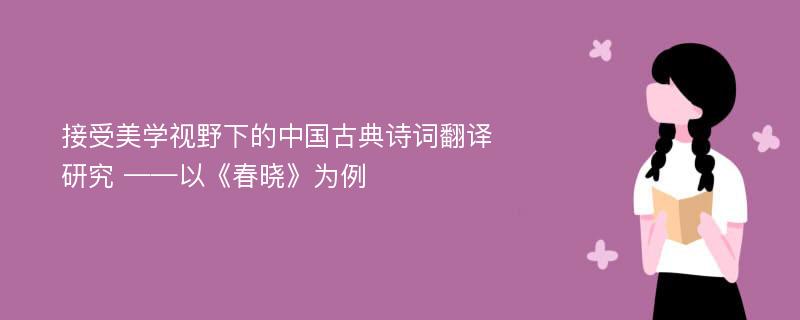
论文摘要
古典诗词是中国文化中的瑰宝之一,自古以来便深深吸引着国内外的文人雅客。同时,中国古典诗词含蓄内敛的特征,导致即使面对同一首诗歌,也是仁者见仁智者见智,正如俗话所说,一千个读者就有一千个哈姆雷特。迄今为止,国内外不少学者都翻译过中国的古典诗词,译本无论在风格、内容,亦或是意境的传达上,都存在着很大的差异。然而,传统的翻译研究主要侧重于分析译本语言层面的转换,着重译本是否“忠实”于原作,其研究的重点也只集中于原作者和原文文本,忽略了不同的读者对于同一文本的接受是有差异的。上世纪六十年代,以姚斯和伊塞尔为代表的康斯坦茨学派所提出的接受美学理论,却首次把研究的重点转移到读者身上,完成了文学研究的中心从文本到读者的转变,提出了期待视野、召唤结构等一系列重要术语,并对读者的地位做了重要论述,完善了对“作者—作品—读者”体系的研究。随着翻译研究的深入,译者的地位逐渐凸显。作为一种文学批评理论,接受美学十分强调读者的能动性。在翻译过程中,译者的身份首先是是原文的读者,其次是译本的作者和创造者。因此,本文试图用接受美学这一理论,来分析中国古典诗词的英译,探讨为什么面对同一文本,不同译者会做出不同的理解和感触,并最终呈现给大家不同的译本。本篇论文的意义在于为古诗《春晓》的研究带来一些启示,同时,使接受美学这一理论的应用更加多样化,另在,以期对翻译研究带来些许意见。无论是从事翻译活动,还是研究分析译本,亦或是对译本进行文学批评,读者的地位和作用都应该被考虑到内,尤其是译者这一特殊的读者。中国古典诗词内容丰富,数量众多。本文主要选取《春晓》及其五个英译本为例。《春晓》是颇受欢迎的唐诗之一,自古以来为人所熟悉。尽管诗篇简短,然而其清新自然的特质数百年来深受读者喜欢。国内外的许多译者都曾翻译过此诗。本文中所选取的五个译本,三个由国内译者所译,其余二个出自国外译者之手。五位译者及其译本在翻译领域均影响甚远。本论文通过对比分析这五个译本在翻译时对诗歌节奏、意象、意境方面不同的把握,折射出不同的译者在面对同一首诗歌时,由于其自身的“期待视野”不同,导致他们面对原诗中众多的“空白”和“意义的不确定点”时,是如何根据自己的理解来对空白进行填补的。通过整篇分析得出结论,接受美学赋予了读者前所未有的权利和地位。任何译本的产生都与译者自身的文化素养,审美眼光,以及情感态度等多方面紧密相连。作为一个特殊的读者,译者积极地参与到对原文本的再创造中。然而,当翻译时,译者不应仅仅发挥自己的创造性,还应忠实于原文本中的已定信息。
论文目录
相关论文文献
- [1].主持人的话(英文)[J]. Social Sciences in China 2015(03)
- [2].A Tentative Study of the Multiple Standard of Literary Criticism[J]. 校园英语 2017(11)
- [3].Analysis of Strategies and Procedures Employed in Translating Literary and Non-literary Texts from the Perspective of Functionalist Theory[J]. 校园英语 2017(09)
- [4].The Translation of Cultural Images——The Application of Intertextuality in the English Versions of You Are This World's April Day[J]. 青春岁月 2017(15)
- [5].Literary Translation:How to Go International[J]. 长江丛刊 2017(12)
- [6].On the Translation of Pun in Literary Works[J]. 校园英语 2017(26)
- [7].An Brief Introduction to Bildungsroman[J]. 校园英语 2017(28)
- [8].不可错过!(英文)[J]. The World of Chinese 2012(02)
- [9].Comparative Analysis of Satire Between Running for Governor and The Scholars[J]. 海外英语 2019(21)
- [10].Zhang Guruo's Translation of Tess of the d'Urbervilles in the view of Aesthetic Theory[J]. 科技经济导刊 2017(30)
- [11].Stylistics and Literary Criticism[J]. Language and Semiotic Studies 2015(02)
- [12].Translation Strategies of Non-literary Texts[J]. 海外英语 2015(22)
- [13].Defamiliarization: the Genius of Literary Device[J]. 海外英语 2017(12)
- [14].Western Theory and the Study of Classical Chinese Literature in North America[J]. Contemporary Social Sciences 2019(06)
- [15].An Analysis of Emily Dickinson's Rebellious Life[J]. 海外英语 2016(22)
- [16].Foregrounding in Stylistics and Analytic Functions of Literary Texts[J]. 语言与文化研究 2012(00)
- [17].Shared Legacy[J]. Beijing Review 2016(19)
- [18].Literary Signs: A Social Practice[J]. Language and Semiotic Studies 2018(01)
- [19].On the Chinese Characteristics of Literary Federation System[J]. 戏剧之家 2017(19)
- [20].主持人的话(英文)[J]. Social Sciences in China 2017(04)
- [21].What is Narrative and Literary Journalism?[J]. 长江丛刊 2018(16)
- [22].Jacques Derrida's Origin of Literature,with Impossible Filiations[J]. 比较文学与世界文学 2014(01)
- [23].CULTURE[J]. China's Foreign Trade 2009(23)
- [24].The Historical Development of Literary Anthropology in China[J]. Contemporary Social Sciences 2018(05)
- [25].文学世家的历史还原(英文)[J]. Social Sciences in China 2012(02)
- [26].Use of Four-character Structures in Literary E-C Translation[J]. 海外英语 2014(02)
- [27].A Research on Guiding Effect of Marxist Literary Theory on Literary Creation[J]. 海外英语 2011(09)
- [28].Cultural Context in Literary Translation——from the Perspective of Explanatory Function and Restrictive Function[J]. 海外英语 2016(05)
- [29].《太阳照常升起》书评(英文)[J]. 疯狂英语(读写版) 2020(04)
- [30].Trans-Cultural Comparative Literature Method:Using Grammar Translation Techniques and Communicative Language Teaching Effectively[J]. 海外英语 2014(19)
